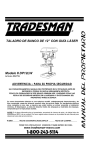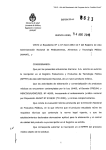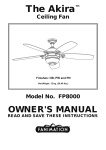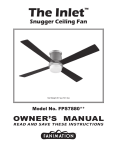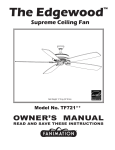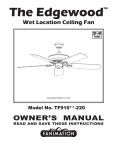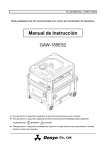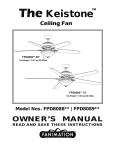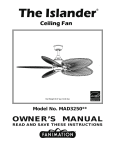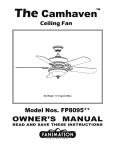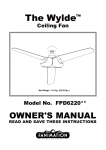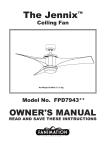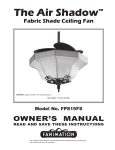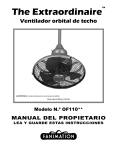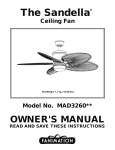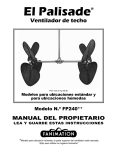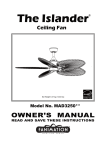Download FP8003 BENTIO CEILING FAN - Img
Transcript
The Multimax ™ Ceiling Fan Net Weight 20.5 lbs (9.3 kgs) Model No. FP8008CH1 OWNER’S MANUAL READ AND SAVE THESE INSTRUCTIONS Important Safety Instructions WARNING: To avoid fire, shock and serious personal injury, follow these instructions. 1. Read your owner’s manual and safety information before installing your new fan. Review the accompanying assembly diagrams. 2. Before servicing or cleaning unit, switch power off at service panel and lock service panel disconnecting means to prevent power from being switched on accidentally. When the service disconnecting means cannot be locked, securely fasten a warning device, such as a tag, to the service panel. 3. Be careful of the fan and blades when cleaning, painting, or working near the fan. Always turn off the power to the ceiling fan before servicing. 4. Do not insert anything into the fan blades while the fan is operating. 5. Do not operate reversing switch until fan blades have come to a complete stop. Additional Safety Instructions 1. To avoid possible shock, be sure electricity is turned off at the fuse box before wiring, and do not operate fan without blades. 2. All wiring and installation procedures must satisfy National Electrical Codes (ANSI/ NFPA 70-1999) and Local Codes. The ceiling fan must be grounded as a precaution against possible electrical shock. Electrical installation should be made or approved by a licensed electrician. 3. The fan base must be securely mounted and capable of reliably supporting at least 35 lbs. (fan and accessories not to exceed 35 lbs. or 15.88 kgs.). See page 4 of owner’s manual for support requirements. Consult a qualified electrician if in doubt. 4. The fan must be mounted with the fan blades at least 7 feet from the floor to prevent accidental contact with the fan blades. 5. Follow the recommended instructions for the proper method of wiring your ceiling fan. If you do not have adequate electrical knowledge or experience, have your fan installed by licensed electrician. 6. Suitable for use with solid-state speed controls. WARNING: To reduce the risk of fire or electric shock, this fan should only be used with Fan Speed Control Part No. UC7067RYL, manufactured by Rhine Electronic Co., Ltd. WARNING : TO REDUCE THE RISK OF ELECTRIC SHOCK, THIS FAN MUST BE INSTALLED WITH A GENERAL USE, ISOLATING WALL CONTROL/SWITCH. WARNING: This product is designed to use only those parts supplied with this product and/or accessories designated specifically for use with this product. Using parts and/or accessories not designated for use with this product could result in personal injury or property damage. WARNING: The fan is suitable for dry location. WARNING: Mount to an outlet box marked acceptable for fan support. This device complies with Part 15 of the FCC Rules. Operation is subject to the following two conditions: (1) This device may not cause harmful interference, and (2) this device must accept any interference received, including interference that may cause undesired operation. If the intentional radiator can be classified as a Class B digital device or a PC peripheral, then shall include the following or equivalent: Note: This equipment has been tested and found to comply with the limits for Class B digital device, pursuant to part 15 of the FCC Rules. These limits are designed to provide reasonable protection against harmful interference in a residential installation. This equipment generates, uses and can radiate radio frequency energy and, if not installed and used in accordance with the instructions, may cause harmful interference to radio or television reception, which can be determined by turning the equipment off and on, the user is encouraged to try to correct the interference by one or more of the following measures: - Reorient or relocate the receiving antenna. - Increase the separation between the equipment and the receiver. - Connect the equipment into an outlet on a circuit different from that to which the receiver is connected. Consult the dealer or an experienced radio/TV technician for help. Note: For a Class A digital device, statements of 15. 105(a) must be included when appropriate for the device in question. LIMITED LIFETIME WARRANTY Extends to the original purchaser of a Fanimation Fan 1. LIMITED LIFETIME MOTOR WARRANTY - If any part of your fan motor fails, due to a defect in materials or workmanship during the lifetime of the original purchaser, Fanimation will provide the replacement part free of charge, when the defective fan is returned to our national service center. Proof of purchase is required. Customer shall be responsible for all costs incurred in the removal or reinstallation and shipping of the product for repairs or replacement. 2. ONE YEAR MOTOR LABOR WARRANTY - If your fan motor fails at any time within one year from the original purchase, due to defects in materials or workmanship, labor to repair the motor will be provided free of charge at our national service center. Purchaser will be responsible for labor charges after this one-year period. Customer shall be responsible for all costs incurred in the removal or reinstallation and shipping of the product for repairs or replacement. 3. If any other part of your fan fails at any time within one year after original purchase, due to a defect in materials or workmanship, we will repair, or replace, at our option, the defective part free of charge for parts and labor performed at our national service center. 4. Because of varying climate conditions, this warranty does not cover changes in the finish, including rusting, pitting, corroding, tarnishing, or peeling. 5. This warranty is void and does not apply to damage from improper installation, neglect, accident, misuse, exposure to extremes of heat or humidity, or as a result of any modification to the original product. 2 LIMITED LIFETIME WARRANTY Extends to the original purchaser of a Fanimation Fan 6. All costs of removal and reinstallation of the fan are the sole responsibility of the owner of the fan and not the store that sold the fan or Fanimation. 7. Fanimation reserves the right to modify or discontinue any product at any time and may substitute any part under this warranty. 8. Under no circumstances may a fan be returned without prior authorization from Fanimation. The receipt of purchase must accompany authorized returns and must be sent freight prepaid to Fanimation. The fan to be returned must be properly packed to avoid damage in transit; Fanimation will not be responsible for any damage resulting from improper packaging. 9. It is understood that any repair or replacement is the exclusive remedy available from Fanimation. There is no other expressed or implied warranty. Fanimation hereby disclaims any and all implied warranties, including, but not limited to those of merchantability and fitness for a particular purpose to the extent permitted by law. Some states do not allow limitations on implied warranties. Fanimation will not be liable for incidental, consequential, or special damages arising out of or in conjunction with product use or performance, except as may otherwise be accorded by law. This warranty gives you special legal rights and you may also have other rights that vary from state to state. 10. A certain amount of wobble is normal and should not be considered a problem or a defect. Table of Contents Unpacking Instructions . . . . . . . . . . . . . . . . . . . . . . . . . . . . . . .4 Energy Efficient Use of Ceiling Fans . . . . . . . . . . . . . . . . . . . . .5 Electrical and Structural Requirements . . . . . . . . . . . . . . . . . .5 How to Assemble Your Ceiling Fan . . . . . . . . . . . . . . . . . . . . . .6 How to Hang Your Ceiling Fan . . . . . . . . . . . . . . . . . . . . . . . . . .8 How to Wire Your Ceiling Fan . . . . . . . . . . . . . . . . . . . . . . . . . .9 How to Install Your Canopy Housing . . . . . . . . . . . . . . . . . . .10 How to Assembly the Housing & Light Kit . . . . . . . . . . . . . . 11 How to Operate Your Ceiling Fan . . . . . . . . . . . . . . . . . . . . . .13 Maintenance . . . . . . . . . . . . . . . . . . . . . . . . . . . . . . . . . . . . . . . .14 How to Clean Your Ceiling Fan Blades . . . . . . . . . . . . . . . . . .14 Trouble Shooting . . . . . . . . . . . . . . . . . . . . . . . . . . . . . . . . . . . .15 Parts List . . . . . . . . . . . . . . . . . . . . . . . . . . . . . . . . . . . . . . . . . .16 Exploded-View Illustration . . . . . . . . . . . . . . . . . . . . . . . . . . . .17 3 This Manual is Designed to Make it as Easy as Possible for You to Assemble, Install, Operate, and Maintain Your Ceiling Fan Tools Needed for Assembly • One Phillips head screwdriver • One stepladder • One ¼˝ blade screwdriver Materials • One wire stripper • Three wire connectors (supplied) Wiring outlet box and box connectors must be of type required by local code. The minimum wire would be a 3conductor (2-wire with ground) of the following size: Installed Wire Length ▲WARNING Up to 50 ft. 50 - 100 ft. Before assembling your ceiling fan, refer to section on proper method of wiring your fan (page 4). If you feel you do not have enough wiring knowledge or experience, have your fan installed by a licensed electrician. Wire Size A.W.G. 14 12 NOTE: Place the parts from the loose parts bags in a small container to keep them from being lost. If any parts are missing, contact your local retailer. Unpacking Instructions For your convenience, check-off each step. As each step is completed, place a check mark. This will ensure that all steps have been completed and will be helpful in finding your place should you be interrupted. ▲WARNING Do not install or use fan if any part is damaged or missing. This product is designed to use only those parts supplied with this product and/or any accessories designated specifically for use with this product by Fanimation. Substitution of parts or accessories not designated for use with this product by Fanimation could result in personal injury or property damage. Contact your retail store for missing or damaged parts. 1. Check to see that you have received the following parts: NOTE: If you are uncertain of part description, refer to exploded view illustration. (Figure 1, page 16) Hanger Bracket • Hardware bags: • Hanger Bracket – Four wire connectors • Downrod/Hanger Ball Assembly – Nine 1/4˝-20x1/2˝ screw • Ceiling Canopy w/spring washer • Canopy Screw Cover – Nine 1/4 steel washer • Fan Motor Assembly – Phillips screwdriver,4˝ • Lower Housing Assembly – Balance Kit • Decorative Lower Hosing Cover • Light Plate Assembly • Socket Plate Assembly • Bulbs (2) • Glass • Blades (4) • Transmitter • Receiver Light Plate Assembly Ceiling Canopy Transmitter Receiver Socket Plate Assembly Downrod/Hanger Ball Assembly Decorative Lower Hosing Cover Fan Motor Assembly Canopy Screw Cover Glass Lower Housing Assembly Bulbs Blades 4 Hardware Bags Energy Efficient Use of Ceiling Fans Using the Ceiling Fan Year Round Summer Season: Use the ceiling fan in the counterclockwise direction. The airflow produced by the ceiling fan creates a wind-chill effect, making you “feel” cooler. Select a fan speed that provides a comfortable breeze, lower speeds consume less energy. Ceiling fan performance and energy savings rely heavily on the proper installation and use of the ceiling fan. Here are a few tips to ensure efficient product performance. Choosing the Appropriate Mounting Location Ceiling fans should be installed, or mounted, in the middle of the room and at least 7 feet above the floor and 18 inches from the walls. If ceiling height allows, install the fan 8 - 9 feet above the floor for optimal airflow. Consult your Fanimation Retailer for optional mounting accessories. Winter Season: Reverse the motor and operate the ceiling fan at low speed in the clockwise direction. This produces a gentle updraft, which forces warm air near the ceiling down into the occupied space. Remember to adjust your thermostat when using your ceiling fan - additional energy and dollar savings could be realized with this simple step! Turn Off When Not in the Room Ceiling fans cool people, not rooms. If the room is unoccupied, turn off the ceiling fan to save energy. Electrical and Structural Requirements Your new ceiling fan will require a grounded electrical supply line of 120 volts AC, 60 Hz, 15 amp circuit. The outlet box must be securely anchored and capable of withstanding a load of at least 50 lbs. Figure 1 depicts different structural configurations that may be used for mounting the outlet box. CEILING WARNING CEILING JOIST To reduce the risk of fire, electrical shock, or personal injury, mount fan to outlet box marked acceptable for fan support of 15.88 kg (35 lbs) or less. Use screws supplied with outlet box. Most outlet boxes commonly used for support of light fixtures are not acceptable for fan support and may need to be replaced. Consult a qualified electrician if in doubt. 2" x 4" OUTLET BOX If your fan is to replace an existing light fixture, turn electricity off at the main fuse box at this time and remove the existing light fixture. Figure 1 WARNING WARNING Turning off wall switch is not sufficient. To avoid possible electrical shock, be sure electricity is turned off at the main fuse box before wiring. All wiring must be in accordance with National and Local codes and the ceiling fan must be properly grounded as a precaution against possible electrical shock. To avoid fire or shock, follow all wiring instructions carefully. Any electrical work not described in these instructions should be done or approved by a licensed electrician. 5 How to Assemble Your Ceiling Fan 1. Loosen the three screws in the upper housing then remove it. Retain the screws and upper housing for installation in Step 6 (Figure 1). Upper Hosing Figure 1 2. Remove the hanger ball portion from the downrod/hangerball assembly by loosening the set screw in the hanger ball until the ball falls freely down the downrod. Remove the pin from the downrod, then remove the hanger ball. Retain the pin and hanger ball for reinstallation in Step 7 (Figure 2). PIN Hanger Ball Set Screw Figure 2 3. Loosen the two set screws in the downrod support. Route black, blue and white lead wires through the downrod (Figure 3). Black, Blue and White Leads DOWNROD Set Screw and Locking Nuts (2) Figure 3 4. Position downrod support and align the clevis pin holes in both parts. Install the clevis pin and secure with the hairpin clip. Tighten the two set screws and locking nuts in the downrod support (Figure 4). DOWNROD Set Screw and Locking Nuts (2) Downrod Support Figure 4 Assemble the Blades: 5. Securely fasten the four blades with screws and steel washers (Figure 5). 1/4"-20x1/2" Screws with steel washers INSTALLATION NOTE Do not connect fan blades until the fan is completely installed. Installing the fan with blades assembled may result in damage to the fan blades. Blade Figure 5 HARDWARE USED: ▲WARNING To reduce the risk of personal injury, do not bend the blades when installing, balancing or cleaning the fan. Do not insert foreign objects in between the rotating blades. 6 1/4"-20 x 1/2" SCREWS W/ Spring Washer x 8 1/4 STEEL WASHER x8 How to Assemble Your Ceiling Fan (Cont’d) 6. Assemble the upper housing onto the fan motor assembly with three screws that removed from Step 1. (Figure 6). Upper Hosing Figure 6 7. Route wires through canopy screw cover and canopy (Figure 7). Canopy Canopy Screw Cover Figure 7 8. Reinstall the hanger ball on the downrod as follows.Route the three 80-inch wires through the hanger ball. Position the pin through the two holes in the downrod and align the hanger ball so the pin is captured in the groove in the top of the hanger ball. Pull the hanger ball up tight against the pin. Securely tighten the set screw in the hanger ball. A loose set screw could create fan wobble (Figure 8). Set Screw PIN Canopy Hanger Ball Downrod Figure 8 9. Before installing fan, measure up approximately 6-9 inches above top of downrod/hanger ball assembly. Cut off excess wire and strip back insulation 1/2” from end of wire. (Figure 9) NOTE: All set screws must be checked and retightened where necessary before installation. Figure 9 7 How to Hang Your Ceiling Fan ▲WARNING To avoid possible electrical shock, be sure electricity is turned off at the main fuse box before hanging. (Figure 1) NOTE: If you are not sure if the outlet box is grounded, contact a licensed electrician for advice, as it must be grounded for safe operation. MAIN FUSE BOX ▲WARNING Figure 1 The fan must be hung with at least 7´ of clearance from floor to blades (Figure 2) CEILING ▲WARNING The outlet box must be securely anchored and capable of withstanding a load of at least 50 lbs. Hanger bracket must seat firmly against outlet box. If the outlet box is recessed, remove wallboard until bracket contacts box. If bracket and/or outlet box are not securely attached, the fan could wobble or fall. NO LESS THAN 7 FEET FLOOR Figure 2 CAUTION Do not connect fan blades until the fan is completely installed. Hanging fan with blades connected may result in damage to the fan blades. Outlet Box Hanger Bracket 1. Securely attach the hanger bracket to the outlet box using the outlet box screws and washers supplied with the outlet box (Figure 3). NOTE: Outlet box screws pass through slotted holes of the hanger bracket (Figure 3). Tab 2. Pull the electric wires in the outlet box down through the opening in the hanger bracket and bend wires up and out of the way so that the hanger ball will easily fit into the hanger bracket. Screw (2) Supplied with Outlet Box Figure 3 Outlet Box 3. Carefully lift the fan and seat the downrod/hanger ball assembly on the hanger bracket that was just attached to the outlet box (Figure 4). Be sure the groove in the ball is lined up with tab on the hanger bracket (Figure 3). Hanger Bracket 4. After splicing, the wiring should be turned upward and pushed carefully up into the outlet box. ▲WARNING Failure to seat tab in groove could cause damage to electrical wires and possible shock or fire hazard. Downrod/Hanger Ball Assembly Figure 4 ▲WARNING To avoid possible shock, do not pinch wires between the downrod/hanger ball assembly and the hanger bracket. 8 How to Wire Your Ceiling Fan ! WARNING To avoid possible electrical shock, be sure electricity is turned off at the main fuse box before hanging (Figure 1). MAIN FUSE BOX NOTE: If you are not sure if the outlet box is grounded, contact a licensed electrician for advice, as it must be grounded for safe operation. Figure 1 1. Slide the receiver unit into the open end of the hanger bracket (Figure 2). RECEIVER UNIT HANGER BRACKET Figure 2 2. Connect green wires from hanger bracket and hanger ball to bare (ground) wire using wire connector supplied. Connect black wire from receiver unit marked “AC IN L” to black supply wire using wire connector supplied. Connect white wire from receiver unit marked “AC IN N” to white supply wire using wire connector supplied. Connect white wire from receiver unit marked “TO MOTOR N” to white wire from fan using wire connector supplied with receiver. Connect black wire from receiver unit marked “TO MOTOR L” to black wire from fan using wire connector supplied. Lastly, connect blue wire from receiver to the blue fan light wire using wire connector supplied. Position all connected wires and receiver antenna to allow installation of ceiling canopy (Figure 3). Figure 3 WARNING HARDWARE USED: Check to see that all connections are tight, including ground, and that no bare wire is visible at the wire connectors except for the ground wire. Do not operate fan until the blades are in place. Noise and motor damage could result. WIRE CONNECTORS 3. After connections have been made, turn leads upward and carefully push leads into the outlet box, with the white and green leads to one side of the box and the black leads towards the other side. The wires should be spread apart with the grounded conductor and the equipment-grounding conductor on one side of the outlet box and the ungrounded conductor on the other side of the outlet box (Figure 4). x 6 WHITE LISTED OUTLET BOX BLACK BLUE BLACK-ANT GREEN - Ground Wire From Hanger Ball Figure 4 9 GREEN - Ground Wire From Hanger Bracket How to Install Your Canopy Housing 1. Remove one of the two shoulder screws in the hanger bracket. Loosen the second shoulder screw without fully removing it. Assemble canopy by rotating key slot in canopy over shoulder screw in hanger bracket. Tighten shoulder screw. Fully assemble and tighten second shoulder screw that was previously removed (Figure 1). Canopy Shoulder Screws (2) WARNING To avoid possible fire or shock, make sure that the electrical wires are completely inside the canopy housing and not pinched between the housing and the ceiling. Figure 1 2. Securely attach and tighten the canopy screw cover over the shoulder screws in the hanger bracket utilizing the key slot twist-lock feature. (Figure 2) Canopy Screw Cover Figure 2 10 How to Assemble the Housing and Light Kit 1. Remove one of the three screws in the support bracket at the bottom of the motor assembly. Slightly loosen the remaining two screws. Assemble the lower housing to the support bracket using the two key slots in the lower housing. Replace the third screw and securely tighten all three screws (Figure 1). Motor Assembly Lower Housing Figure 1 2. Remove three screws from lower housing. Assemble the light plate to the lower housing and securely tighten all three screws (Figure 2). 2A. Don’t install the light plate assembly if you don’t want the light kit. Assemble the decorative lower housing cover to the lower housing by push and snap in (Figure 2A). Screws (3) Lower Housing Lower Housing Light Plate Assembly Decorative lower housing cover Figure 2 Figure 2A 3. Connect the 2-pin connector from the socket plate assembly to 2-pin connector from motor assembly (Figure 3). Motor Assembly 2-PIN Connector Socket Plate 2-PIN Connector Socket Plate Assembly Figure 3 4. Remove one of the three screws in the plate assembly. Slightly loosen the remaining two screws. Assemble the socket plate to the lower housing using the two key slots. Replace the third screw and securely tighten all three screws (Figure 4). Lower Housing Socket Plate Assembly Figure 4 11 How to Assemble the Housing and Light Kit (cont’d) 5. Insert light bulbs into sockets (Figure 5). Socket Plate Bulb Figure 5 6. Assemble the glass to the socket plate assembly by twisting in a clockwise direction. Do not over-tighten (Figure 6). Socket Plate Glass Figure 6 12 How to Operate Your Ceiling Fan 1. Restore electrical power to the outlet box by turning the electricity on at the main fuse box (Figure 1). WARNING MAIN FUSE BOX Check to see that all connections are tight, including ground, and that no bare wire is visible at the wire connectors, except for the ground wire. Do not operate fan until the blades are in place. Noise and fan damage could result. Figure 1 2. LEARN MODE PROCESS: (Figure 2) 1. Control and receiver have been factory programmed. If replacing the transmitter or receiver, the learn mode process will need to be used. ON/OFF AAA AAA AAA DIMMER AAA 2. After installing the unit and restoring power to your fan, open the battery cover (with batteries, DC1.5V/AAA 4pcs, installed) and press and hold the ”LEARNING BUTTON” 1~3seconds with a ball-point pen or similar object. FAN will turn off and then turn to medium speed and light on, which indicates that the learning process has completed. LEARNING BUTTON LIGHT DIMMER FUNCTION SELECT SWITCH Figure 2 IMPORTANT: You must press the “LEARNING BUTTON” within 60 seconds of restoring power to the fan. Remote does not need to be re-learned when replacing the battery. 3. If light kit has CFL bulbs, please slide the “light dimmer function select switch” to on/off position. If installed incandescent light bulbs onto ceiling fan, please slide the “light dimmer function select switch” to dimmer position. 4. Please note, the remote can learn multiple receivers. Install Remote Control Wall Mount Holder with two screws. 3. REMOTE FUNCTIONS: (Figure 3) : Touch and release immediately to turn fan on or off : Touch and release immediately to turn change fan speeds low/medium/high : Touch to select run time desired—from 1 to 12 hours. Fan will turn off after selected time duration. : Touch and release immediately to turn light on or off (CFL) Touch and release this key to brighten light to the desired level (Incandescent) : If light is on, touch and release immediately and light will turn off after 3 minutes : If light is off, touch and release immediately and light will turn on. After 3 minutes, light will turn off. Figure 3 4. If airflow is desired in the opposite direction, turn the fan off and wait for the blades to stop turning. Slide the coupling cover up to expose the reverse switch. Then slide the reverse switch on top of motor assembly to the opposite position and turn fan on again (Figure 4). Reverse Switch Reverse Switch Information Season Rotation Direction Switch Position Summer Winter Counter-Clockwise Clockwise Left Right Upper Housing 13 Figure 4 Maintenance 1. Periodic cleaning of your new ceiling fan is the only maintenance that is needed. When cleaning, use only a soft brush or lint free cloth to avoid scratching the finish. Abrasive cleaning agents are not required and should be avoided to prevent damage to finish. CAUTION Do not use water when cleaning your ceiling fan. It could damage the motor or the finish and create the possibility of electrical shock. How to Clean Your Ceiling Fan Blades Periodic light dusting of the blades is recommended. A feather duster will work best. Avoid using water, cleansers, or harsh rags, which can warp and ruin the finish. 14 Trouble Shooting ! WARNING For your own safety turn off power at fuse box or circuit breaker before trouble shooting your fan. Trouble Probable Cause 1. Fuse or circuit breaker blown. 1.FAN WILL NOT START 2. Loose power line connections to the fan, or loose switch wire connections in the switch housing. 3. Reversing switch in neutral position. 4. Dead battery in remote control. 1. Blades not attached to fan. 2. Loose screws in motor housing. 2.FAN SOUNDS NOISY 3. Screws securing fan blade holders to motor flywheel are loose. 4. Wire connectors inside housing rattling. 5. Motor noise caused by solid state variable speed control. 6. Screws holding blades to blade holders are loose. 7. Lower housing support set screw loose. 1. Setscrew in downrod support is loose. 3.FAN WOBBLES EXCESSIVELY 2. Setscrew in downrod/hanger ball assembly is loose. 3. Screws securing fan blade holders to motor hub are loose. 4. Blade holders not seated properly. 5. Hanger bracket and/or ceiling outlet box is not securely fastened. 6. Fan blades out of balance. Suggested Remedy 1. Check main and branch circuit fuses or circuit breakers. 2. Check line wire connections to fan and switch wire connections in the switch housings. CAUTION: Make sure main power is turned off ! 3. Make sure reversing switch position is all the way to one side. 4. Replace with fresh battery. 1. Attach blades to fan before operating. 2. Check to make sure all screws in motor housing are snug (not overtight). 3. Check to make sure the screws which attach the fan blade holders to the motor flywheel are tight. 4. Check to make sure wire connectors in switch housing are not rattling against each other or against the interior wall of the switch housing. CAUTION: Make sure main power is turned off ! 5. Some fan motors are sensitive to signals from solid-state variable speed controls. Solid-state controls are not recommended, choose an alternative control method. 6. Tighten screws securely. 7. Tighten set screw securely. 1. Tighten both setscrews securely in downrod support. 2. Tighten the setscrew in the downrod/ hanger ball assembly. 3. Check to be sure screws which attach the fan blade holders to the flywheel are tight. 4. Check to be sure the fan blade holders seat firmly and uniformly to the surface of the motor housing. If holders are seated incorrectly, loosen the screws and retighten. 5. Tighten the hanger bracket screws to the outlet box, and secure outlet box. 6. Balance blades using balance kit provided in hardware bag. 1. If possible, consider using a longer downrod. For example, use a 12” downrod instead of the 4½” downrod that comes with your fan. 4.NOT ENOUGH AIR MOVEMENT 15 Parts List Model No. FP8008CH1 Reference # Description Part # 1 2 3 4 5 6 7 8 9 10 11 12 13 14 Hanger Bracket Assembly w/Screws Downrod / Hanger Ball Assembly Canopy Canopy Screw Cover Assembly Fan Motor Assembly Lower Housing Assembly Decorative Lower Housing Cover Light Plate Assembly Socket Plate Assembly Light Bulb Glass Blade Set Transmitter-Touch Screen Receiver AP255BL ADR1-6CH P800817CH AP260CH AMA8008CH AP800820CH P800809BL AP800821CH AP800822WH PPGU24C18 P800823OP AP800806 MH/CY TRL8TS RECAN54 15 — — — — — Bag Assembly, Loose Parts: Wire Connector (4) HDWFP8008CH — — — — — Screw, 1/4"-20 x 1/2" (9) Steel Washer, 1/4” (9) 4” Phillips Head Screwdriver Balance Kit ** Insert FINISH CODES (Refer to fan model number located on downrod support) Before discarding packaging material, be certain all parts have been removed. HOW TO ORDER REPAIR PARTS When ordering repair parts, always give the following information: • • • Part Number Part Description Fan Model Number Contact your retail store for repair parts. 16 The Multimax™ - FP8008CH1 Exploded-View 1 14 13 2 3 4 5 12 6 7 8 9 10 11 NOTE: The illustration shown is not to scale or its actual configurations may vary. 17 15 10983 Bennett Parkway Zionsville, IN 46077 Toll Free (888) 567-2055 FAX (866) 482-5215 Outside U.S. call (317) 733-4113 Fanimation Visit Our Website www.fanimation.com Copyright 2012 2012/06 V.01 The Multimax ™ Ventilador de techo Peso neto 20.5 lb (9.3 kg) Modelo N.º FP8008CH1 MANUAL DEL PROPIETARIO LEA Y GUARDE ESTAS INSTRUCCIONES Tenga en cuenta todas las advertencias que se muestran Instrucciones de seguridad importantes ADVERTENCIA: Siga estas instrucciones para prevenir incendios, descargas eléctricas y lesiones personales graves. 1. Lea el manual del propietario y la información de seguridad antes de instalar su nuevo ventilador. Observe los diagramas de ensamblaje adjuntos. 2. Antes de llevar a cabo el mantenimiento o la limpieza de la unidad, desconecte la electricidad en el panel de servicio y bloquee los medios de desconexión del mismo para evitar que se active accidentalmente. Si no se pueden bloquear los medios de desconexión del servicio, coloque un dispositivo de advertencia, como una etiqueta, en el panel de servicio. 3. Tenga cuidado con la estructura y las aspas del ventilador cuando limpie, pinte o trabaje cerca del mismo. Desconecte siempre la electricidad del ventilador de techo antes de llevar a cabo el mantenimiento. 4. No coloque nada en las aspas del ventilador cuando éste se encuentra en funcionamiento. 5. No accione el conmutador inversor hasta que las aspas del ventilador se hayan detenido por completo. Instrucciones de seguridad adicionales 1. Para evitar posibles descargas eléctricas, asegúrese de que la electricidad esté desconectada en la caja de fusibles antes de realizar la instalación eléctrica, y no haga funcionar el ventilador sin las aspas. 2. Todos los procedimientos de conexión eléctrica e instalación deben cumplir con los Códigos eléctricos nacionales (ANSI/NFPA 70-1999) y Códigos locales. El ventilador de techo debe estar conectado a tierra a fin de prevenir posibles descargas eléctricas. La instalación eléctrica debe ser llevada a cabo o aprobada por un electricista autorizado. 3. Se debe fijar bien la base del ventilador; ésta debe ser capaz de soportar sin problemas al menos 15,9 kg (35 lb). Consulte la página 20 del manual del propietario para ver los requisitos de soporte. Si tiene dudas, consulte a un electricista calificado. 4. Las aspas del ventilador deben instalarse por lo menos a 2 m (7 pies) del suelo, a fin de evitar un contacto accidental con las mismas. 5. Siga las recomendaciones sobre el método correcto de instalación eléctrica de su ventilador de techo. Si no posee la experiencia o los conocimientos eléctricos adecuados, contrate a un electricista autorizado para instalar el ventilador. 6. Apto para usar con controles de velocidad de estado sólido. ADVERTENCIA: Para reducir el riesgo de incendio o una descarga eléctrica, este ventilador sólo debe utilizarse con la velocidad del ventilador Control pieza UC7067RYL, fabricado por Rin Electronic Co., Ltd. PARA REDUCIR EL RIESGO DE DESCARGAS ELÉCTRICAS, ESTE VENTILADOR SE DEBE INSTALAR CON UN CONTROL/INTERRUPTOR DE PARED AISLADO. ADVERTENCIA: Este producto está diseñado para ser usado sólo con las piezas suministradas o los accesorios indicados específicamente para el mismo. Si utiliza piezas o accesorios que no están indicados para su uso con este producto, podría sufrir lesiones personales o dañar el ventilador. ADVERTENCIA: Este producto está diseñado para ser usado sólo con las piezas suministradas o los accesorios indicados específicamente para el mismo. Si utiliza piezas o accesorios que no están indicados para su uso con este producto, podría sufrir lesiones personales o dañar el ventilador. ADVERTENCIA: El ventilador es ideal para lugares secos. ADVERTENCIA: Monte a una caja de salida aceptable para apoyo de los aficionados. Este equipo cumple con lo establecido en la Parte 15 de la Normativa FCC. Su funcionamiento está sujeto a las dos condiciones siguientes: (1) Este equipo no causará interferencias perjudiciales y (2) este equipo tolerará cualquier interferencia recibida, incluidas las interferencias que puedan provocar un funcionamiento no deseado. Si el radiador intencional puede ser clasificado como un dispositivo digital de clase B o un periférico del ordenador, entonces se deberán incluir los siguientes o equivalentes: Nota: Tras someterlo a las pruebas correspondientes, se ha determinado que este equipo cumple con los límites establecidos para dispositivos digitales de Clase B de conformidad con la parte 15 de la Normativa FCC. Estos límites se han establecido con el objetivo de aportar una protección razonable contra interferencias perjudiciales cuando el equipo se utiliza en el hogar. Este equipo genera, utiliza y puede emitir energía de radiofrecuencia y, a menos que se instale y se utilice de acuerdo con el manual de instrucciones, puede provocar interferencias perjudiciales en las comunicaciones por radio y televisión. Si el equipo produce interferencias perjudiciales en la recepción de radio o televisión, lo cual puede probarse encendiendo y apagando el equipo, se recomienda al usuario corregir dichas interferencias tomando una o varias de las siguientes medidas: - Modificar la orientación o ubicación de la antena de recepción; - Aumentar la separación entre el equipo y el receptor; - Conectar el equipo a una toma de corriente o circuito diferente al del receptor; Consulte al distribuidor o a un técnico especialista de radio o TV para obtener más ayuda. Nota: Para un dispositivo digital de clase A, la declaración de 15. 105(a) debe ser incluida cuando sea apropiada para el dispositivo en cuestión. GARANTÍA LIMITADA DE POR VIDA Se extiende al comprador original de un ventilador Fanimation 1. GARANTÍA LIMITADA DE POR VIDA DEL MOTOR - Si se produjera una falla en alguna de las partes del motor de su ventilador debido a un defecto en los materiales o en la fabricación durante el tiempo de vida del comprador original, Fanimation proporcionará la pieza de repuesto sin cargo una vez que el ventilador defectuoso sea devuelto a nuestro centro de servicios nacional. Se requiere comprobante de venta. El cliente se hará responsable de todos los gastos de remoción o reinstalación y envío del producto para reparaciones o sustitución. 2. GARANTÍA DE MANO DE OBRA DEL MOTOR POR UN AÑO - Si el motor de su ventilador fallara antes de cumplirse un año a partir del momento de su compra original debido a defectos en los materiales o en la fabricación, se le efectuará la reparación del mismo sin cargo en nuestro centro de servicios nacional. El comprador se hará responsable de los gastos de mano de obra luego del período de un año. El cliente se hará responsable de todos los gastos de remoción o reinstalación y envío del producto para reparaciones o sustitución. 3. Si otra pieza del ventilador fallara dentro del período de un año a partir de la fecha de compra original debido a un defecto en los materiales o en la fabricación, repararemos o sustituiremos, según creamos conveniente, la pieza defectuosa sin cargo alguno en nuestro centro de servicios nacional. 4. Debido a las diversas condiciones climáticas, esta garantía no cubre cambios en la terminación, incluidos oxidación, corrosión, falta de brillo o peladuras. 5. Esta garantía es nula y no se aplica a daños por instalación incorrecta, negligencia, accidentes, uso indebido, exposición al calor o a la humedad en exceso, o como resultado de cualquier modificación realizada al producto original. GARANTÍA LIMITADA DE POR VIDA Se extiende al comprador original de un ventilador Fanimation 6. Todos los gastos de remoción y reinstalación del ventilador son responsabilidad exclusiva del propietario, y no de la tienda que vendió el ventilador ni de Fanimation. 7. Fanimation se reserva el derecho de modificar o discontinuar un producto en cualquier momento, o sustituir cualquier pieza según lo establecido por esta garantía. 8. En ningún caso se podrá devolver un ventilador sin previa autorización por parte de Fanimation. Las devoluciones autorizadas deberán ir acompañadas del recibo de venta y deberán enviarse a Fanimation, previo pago del flete. El ventilador que se devuelva deberá estar embalado en forma adecuada a fin de evitar daños durante el transporte. Fanimation no se hará responsable de los daños que resulten del embalaje incorrecto del producto. 9. Se entiende que las reparaciones y las sustituciones son el único recurso disponible de Fanimation. No existe ninguna otra garantía expresa o implícita. Por la presente, Fanimation niega todas las garantías implícitas, que incluyen, entre otras, la comerciabilidad y la aptitud para determinado fin hasta donde la ley lo permita. Algunos estados no permiten limitaciones sobre las garantías implícitas. Fanimation no se hará responsable por daños accidentales, resultantes o especiales derivados del uso o el rendimiento del producto o en conjunción con éste, excepto en los casos en los que la ley así lo disponga. Esta garantía le otorga derechos legales especiales y es posible que también goce de otros derechos que pueden variar según el estado. 10. Es normal que se produzca un cierto movimiento oscilante y esto no debe considerarse un problema o defecto. Tabla de contenidos Instrucciones para el desempaque. . . . . . . . . . . . . . . . . . . . . . . . . . . . .22 Uso eficiente de la energía en ventiladores de techo. . . . . . . . . . . . . . 23 Requisitos eléctricos y estructurales. . . . . . . . . . . . . . . . . . . . . . . . . . .23 Cómo ensamblar el ventilador de techo . . . . . . . . . . . . . . . . . . . . . . . .24 Cómo colgar el ventilador de techo . . . . . . . . . . . . . . . . . . . . . . . . . . . .26 Cómo realizar la instalación eléctrica del ventilador de techo . . . . . . 27 Instalación de la cubierta del capuchón . . . . . . . . . . . . . . . . . . . . . . . . 28 Cómo instalar lacarcasa y el kit de luces . . . . . . . . . . . . . . . . . . . . . . 29 Cómo utilizar su ventilador de techo . . . . . . . . . . . . . . . . . . . . . . . . . . .31 Mantenimiento . . . . . . . . . . . . . . . . . . . . . . . . . . . . . . . . . . . . . . . . . . . . .32 Cómo limpiar su aspas del ventilador . . . . . . . . . . . . . . . . . . . . . . . . . .32 Solución de problemas . . . . . . . . . . . . . . . . . . . . . . . . . . . . . . . . . . . . . .33 Lista de piezas . . . . . . . . . . . . . . . . . . . . . . . . . . . . . . . . . . . . . . . . . . . . .34 Ilustración del despiece. . . . . . . . . . . . . . . . . . . . . . . . . . . . . . . . . . . . . .35 Este manual está diseñado para facilitar al máximo el ensamblaje, la instalación, el funcionamiento y el mantenimiento de su ventilador de techo. Herramientas necesarias para el ensamblaje • Destornillador Phillips • Escalera de tijera • Destornillador de ¼˝ Materiales La caja de distribución eléctrica y los conectores de la caja deben ser del tipo requerido por el código local. El cable más pequeño debe ser un cable de tres conductores (de dos conductores con conexión a tierra) del siguiente tamaño: tamaño del cable según el A.W.G. longitud del cable instalado (Calibre de Alambre Estadounidense) hasta 15,2 m (50 pies) 14 de 15,2 a 30,5 m (50 a 100 pies) 12 • Pelacables • Tres conectores de cables (incluidos) ADVERTENCIA Antes de ensamblar el ventilador de techo, consulte la sección sobre el método correcto de instalación eléctrica del ventilador (página 18). Si siente que no posee la experiencia o los conocimientos eléctricos necesarios, contrate a un electricista autorizado para instalar el ventilador. NOTA: coloque las piezas de las bolsas de piezas individuales en un contenedor pequeño para evitar que se extravíen. Si faltan piezas, pón gase en contacto con su proveedor local. Instrucciones para el desempaque Para su comodidad, marque cada uno de los pasos. A medida que completa cada paso, coloque una marca de verificación. Con esto se asegurará de completar todos los pasos y podrá saber desde dónde retomar si fuera interrumpido. ADVERTENCIA No instale ni utilice el ventilador si falta alguna pieza o si hay piezas dañadas. Este producto está diseñado para ser usado sólo con las piezas suministradas o los accesorios indicados por Fanimation específicamente para el mismo. La sustitución de piezas o accesorios no designados por Fanimation para usar con este producto podría ocasionar lesiones personales o daños en el ventilador. Póngase en contacto con su tienda si faltan piezas o hay piezas dañadas. 1. Verifique que haya recibido las siguientes piezas: NOTA: Si no está seguro de la descripción de una pieza, consulte la ilustración del despiece. (Figura 1, page 33) Unidad del soporte de suspensión • Unidad del soporte de • Bolsa de accesorios: suspensión – Cuatro conectores de los cables • Unidad del barral/de la – Nueve Arandela del tornillo semiesfera de 1/4"-20x1/2" • Capuchón de techo – Nueve Arandela de acero de 1/4 • Cubierta para el tornillo del – Destornillador Phillips de 4” capuchón – kit de balanceo • Unidad del motor del ventilador • Unidad del Inferior de la carcasa • Cubierta decorativa • Placa del kit de luces • Unidad del Placa del zócalo • Bombilla (2) • Vidrio • Aspas(4) • Transmisor • Unidad del receptor Placa del kit de luces Capuchón de techo Transmisor Unidad del receptor Unidad del Placa del zócalo Unidad del barral/de la semiesfera Cubierta decorativa Unidad del motor del ventilador Cubierta para el tornillo del capuchón Bombilla Vidrio Unidad del Inferior de la carcasa Aspas 22 Bolsa de accesorios Uso eficiente de la energía en ventiladores de techo El nivel de rendimiento y ahorro de energía de los ventiladores de techo dependen de su correcta instalación y uso. A continuación le presentamos algunas sugerencias para asegurar un rendimiento eficiente del producto. Uso del ventilador de techo todo el año En verano: Use el ventilador de techo en sentido contrario a las agujas del reloj. El flujo de aire que produce el ventilador creará un efecto frío del aire que lo refrescará más. Seleccione una velocidad que le proporcione una brisa confortable. Las velocidades más bajas consumen menos energía. Selección del lugar de montaje adecuado Los ventiladores de techo se deben instalar en el centro de la habitación, a 2 m (7 pies) de altura del piso como mínimo y 0,5 m (18 pulgadas) de las paredes. Si la altura del techo lo permite, instale el ventilador a 2,5 m (8-9 pies) por encima del suelo para un flujo de aire óptimo. Consulte en su tienda minorista de Fanimation para obtener accesorios de montaje opcionales. En invierno: Invierta el motor y haga funcionar el ventilador de techo a velocidad baja y en el sentido de las agujas del reloj. Esto produce una suave corriente ascendente, que obliga al aire cálido que se acumula cerca del techo a bajar al espacio ocupado. No olvide ajustar el termostato cuando utilice el ventilador de techo. Con este sencillo paso puede ahorrar energía adicional y dinero. Apague el ventilador cuando no se encuentre en la habitación Los ventiladores son para refrescar a la gente, no a las habitaciones. Si la habitación está vacía, apague el ventilador de techo para ahorrar energía. Requisitos eléctricos y estructurales Su nuevo ventilador de techo requiere una línea de suministro eléctrico con conexión a tierra de 120 voltios de CA, 60 Hz, circuito de 15 amperios. La caja de distribución eléctrica debe estar bien asegurada y debe ser capaz de soportar una carga de, al menos, 22,7 kg (50 lb). La Figura 1 muestra diversas configuraciones estructurales que podrían utilizarse para montar la caja de distribución eléctrica. Techo ADVERTENCIA Vigas del techo Para reducir el riesgo de incendios, descargas eléctricas o lesiones personales, fije el ventilador a la caja de distribución eléctrica marcada como aceptable para un peso. Utilice los tornillos suministrados con la caja de distribución eléctrica. La mayoría de las cajas de distribución eléctricas que comúnmente se utilizan como soporte de lámparas no sirven como soporte de ventiladores y es posible que deban reemplazarse. Consulte a un electricista calificado si tiene dudas. 2˝ x 4˝ Caja de distribución eléctrica Figura 1 Si el ventilador reemplazará a una lámpara existente, desconecte la electricidad de la caja de fusibles principal y retire la lámpara. ADVERTENCIA A fin de evitar incendios o descargas eléctricas, siga con cuidado todas las instrucciones de instalación eléctrica. Cualquier trabajo eléctrico que no se describa en estas instrucciones deberá ser realizado o aprobado por un electricista autorizado. ADVERTENCIA Apagar el interruptor de pared no es suficiente. Para evitar posibles descargas eléctricas, asegúrese de que la electricidad esté desconectada en la caja de fusibles principal antes de realizar la instalación eléctrica. Toda instalación eléctrica debe cumplir con los códigos nacionales y locales y el ventilador de techo debe tener la conexión a tierra adecuada como forma de precaución ante posibles descargas eléctricas. 23 Cómo ensamblar el ventilador de techo 1. Afloje tres tornillos en el acoplador de superior de la carcasa y luego retirarla. Conserve los tornillos de superior de la carcasa y el acoplador para la instalación en el paso 6 (Figura 1). superior de la carcasa Figura 1 2. Extraiga la pieza de la bola colgante de la unidad de la bola colgante / varilla aflojando el tornillo de presión de la bola colgante hasta que la bola se libere de la varilla. Retire el pasador del barral y luego extraiga la semiesfera. Conserve el pasador y la semiesfera para su reinstalación en el Paso 7 (Figura 2). Pasador Ranura de la bola colgante Tornillo de fijación Figura 2 3. Afloje los dos tornillos de fijación del soporte del barral Introduzca los cables de color negro, azul y blanco a través de la varilla (Figura 3). NEGRO, AZUL Y BLANCO LLEVA Tornillo de fijación Y tuercas (2) Soporte de la varilla Figura 3 4. Coloque el soporte de la varilla y alinee los orificios de la clavija de horquilla en ambas piezas. Instale la clavija de horquilla y asegúrela con la pinza de horquilla. Fije los dos tornillos de presión y las tuercas de seguridad en el soporte de la varilla interior (Figura 4). Soporte de la varilla Soporte de la varilla Tornillo de fijación Y tuercas (2) Figura 4 Ensamblar el aspa: 5. Asegure bien las cuatro aspas con tornillos y arandelas de acero. (Figura 5). Tornillo de 1/4"-20x1/2" con arandelas de acero NOTA DE INSTALACIÓN No conecte las aspas hasta que el ventilador esté totalmente instalado. Instalar el ventilador con las aspas colocadas podría ocasionar daños en las mismas. Aspa Figura 5 Aditamentos utilizados: ADVERTENCIA Para reducir el riesgo de lesiones personales, no doble las aspas al instalar, balancear o limpiar el ventilador. No coloque objetos extraños entre las aspas del ventilador en funcionamiento. 24 Tornillos Phillips de 1/4"-20 x 1/2" x 8 Arandelas de acero de 1/4 x8 Cómo ensamblar el ventilador de techo (cont.) 6. Ensamble la superior de la carcasa del interruptor al Unidad del motor del ventilador con tres tornillos de eliminar desde el paso 1 (Figura 6). superior de la carcasa Figura 6 7. Pase los la la cubierta para el tornillo y el capuchón y Capuchón de techo (Figura 7) . Capuchón de techo la cubierta del tornillo de la base Figura 7 8. Vuelva a colocar la semiesfera en el barral como se indica a continuación. Pase los tres cables de 2.03 m (80˝) a través de la semiesfera. Pase el pasador a través de los dos orificios en el barral y alinee la semiesfera de modo que el pasador quede atrapado en la ranura de la parte superior de la misma. Empuje la semiesfera hacia arriba, bien ajustada contra el pasador. Ajuste firmemente el tornillo de fijación en la semiesfera. Si el tornillo de fijación está flojo, podría provocar oscilación del ventilador (Figura 8). Pasador Tornillo de fijación Capuchón de techo Bola para colgar Soporte de la varilla Figura 8 15,2 4 22,8 cm a 6 cm 9. Corte el exceso de cable aproximadamente de 15 a 23 cm (6 a 9 pulgadas) por encima de la parte superior del barral. Pele 1,2 cm (½˝) del aislamiento en cada extremo del cable (Figura 9). NOTA: Se deben revisar todos los tornillos de fijación y volver a ajustarlos cuando sea necesario antes de realizar la instalación. Figura 9 25 Cómo colgar el ventilador de techo ADVERTENCIA Para evitar posibles descargas eléctricas, asegúrese de que la electricidad esté desconectada en la caja de fusibles principal antes de colgar el ventilador. (Figura 1) NOTA: Si no está seguro de si la caja de distribución eléctrica tiene conexión a tierra, pida asesoramiento a un electricista autorizado, ya que la conexión a tierra es fundamental para un funcionamiento seguro. PRINCIPAL CAJA DE FUSIBLES Figura 1 ADVERTENCIA EI Techo Las aspas del ventilador deben estar suspendidas, al menos, a 2 m (7´) del piso. (Figura 2) ADVERTENCIA La caja de distribución eléctrica debe estar bien asegurada y ser capaz de soportar una carga de, al menos, 22,7 kg (50 lb). El soporte de suspensión debe estar colocado firmemente contra la caja de distribución eléctrica. Si la caja de distribución eléctrica está empotrada, retire la tablaroca hasta que el soporte haga contacto con la caja. Si el soporte o la caja de distribución eléctrica no están bien asegurados, el ventilador podría oscilar o caerse. No menos de 2,13 m EI Piso Figura 2 Caja de distribución eléctrica PRECAUCIÓN No conecte las aspas hasta que el ventilador esté totalmente instalado. Colgar el ventilador con las aspas conectadas podría ocasionar daños en las mismas. Soporte de suspensión 1. Fije bien el soporte de suspensión a la caja de distribución con los tornillos y las arandelas suministrados con la misma (Figura 3). NOTA: Se deben pasar los tornillos de la caja de distribución eléctrica a través de los orificios que se encuentran en el soporte de suspensión (Figura 3). Tornillos (2) suministrados con la caja de distribución eléctrica. 2. Pase los cables eléctricos de la caja de distribución eléctrica a través de la abertura del soporte de suspensión, dóblelos hacia arriba y apártelos de modo que la semiesfera se ajuste fácilmente en el soporte de suspensión. Pestaña Figura 3 Caja de distribución eléctrica 3. Con cuidado, levante el ventilador y apoye la unidad del barral/de la semiesfera en el soporte de suspensión que acaba de fijar a la caja de distribución eléctrica (Figura 4). Asegúrese de que la ranura en la semiesfera esté alineada con el reborde del soporte de suspensión (Figura 3). Soporte de suspensión 4. Después de empalmar, la conexión eléctrica debe doblarse hacia arriba e insertarse con cuidado en la caja de distribución eléctrica. ADVERTENCIA Si la pestaña no está en la ranura, podrían producirse daños en los cables eléctricos y posibles descargas eléctricas o incendios. Figura 4 ADVERTENCIA Para evitar una posible descarga eléctrica, no aprisione los cables entre la unidad del barral/de la semiesfera y el soporte de suspensión. 26 Unidad del barral/de la semiesfera Cómo realizar la instalación eléctrica del ventilador de techo ▲ADVERTENCIA Para evitar posibles descargas eléctricas, asegúrese de que la electricidad esté desconectada en la caja de fusibles principal antes de realizar la instalación eléctrica. (Figura 1) NOTA: Si no está seguro de si la caja de distribución eléctrica tiene conexión a tierra, pida asesoramiento a un electricista autorizado, ya que la conexión a tierra es fundamental para un funcionamiento seguro. PRINCIPAL CAJA DE FUSIBLES Figura 1 NOTE: El mando a distancia incluido en este ventilador tiene 16 combinaciones diferentes de códigos. Para evitar posibles interferencias desde o hacia otros mandos a distancia, modifique el código de combinación de su transmisor y receptor. 1. Deslice la unidad del receptor en el extremo abierto del soporte colgante. (Figura 2) UNIDAD DEL RECEPTOR soporte colgante Figura 2 Azul NEGRO - Ant. CAJA DE TOMA DE CORRIENTE LISTADA Blanco al motor otor al m uz al Negro Negro al 2. Conecte los cables verdes desde el soporte colgante y la bola colgante en el cable desnudo (toma de tierra) utilizando el conector de cables suministrado. Conecte el cable negro desde la unidad del receptor marcado “AC IN L” al cable negro de suministro de electricidad utilizando el conector de cables suministrado. Conecte el cable blanco desde la unidad del receptor marcado “AC IN N” al cable blanco de suministro de electricidad utilizando el conector de cables suministrado. Conecte el cable blanco desde la unidad del receptor marcado “TO MOTOR N” al cable blanco del ventilador utilizando el conector de cables suministrado con el receptor. Conecte el cable blanco desde la unidad del receptor marcado “TO MOTOR L” al cable blanco del ventilador utilizando el conector de cables suministrado con el receptor. Por último, conecte el cable azul del receptor al cable azul de la luz del ventilador utilizando el conector de cables suministrado. Coloque todos los cables conectados y la antena del receptor para permitir la instalación de la cubierta del techo. (Figura 3) Hogares de suministro CABLE VERDE (Toma de tierra) Negro CABLE VERDE (Toma de tierra de la bola colgante) CABLE VERDE (Toma de tierra del soporte colgante) Blanco Blanco Figura 3 Aditamentos utilizados Conectores de cable x 6 ADVERTENCIA Verifique que todas las conexiones estén ajustadas, incluida la conexión a tierra, y que no haya conductores desnudos visibles en los conectores, excepto el conductor con conexión a tierra. No opere el ventilador hasta que las aspas estén instaladas. Podría ocasionar ruidos y daños al motor. CAJA DE TOMA DE CORRIENTE LISTADA 3. Una vez haya hecho las conexiones, coloque los cables hacia arriba y empújelos cuidadosamente hacia dentro de la caja de la toma de corriente, poniendo los cables blancos y verdes a un lado de la caja y los negros hacia el otro lado. Los cables deben ser colocados de forma extendida poniendo el conductor de la toma de tierra y el conductor de toma de tierra del equipo a un lado de la caja, colocando el conductor sin toma de tierra en el otro lado de la caja. (Figura 4) Blanco Negro Azul VERDE - Toma de tierra de la bola colgante NEGRO-ANT. Figura 4 27 VERDE - Toma de tierra del soporte colgante Instalación de la cubierta del capuchón 1. Retire uno de los dos tornillos de reborde de la abrazadera para colgar. Afloje el segundo tornillo de reborde sin retirarlo del todo. Ensamble la base girando el chavetero de la base sobre el tornillo de reborde de la abrazadera para colgar. Ajuste el tornillo de reborde. Ensamble por completo el segundo tornillo de reborde que antes había retirado y ajústelo. (Figura. 1) Capuchón de techo Tornillo de fijación (2) ADVERTENCIA Para evitar posibles incendios o descargas eléctricas, asegúrese de que los cables eléctricos se encuentren completamente adentro de la cubierta del capuchón y de que no estén aprisionados entre la cubierta y el techo. Figura 1 2. Coloque y ajuste firmemente la cubierta para el tornillo de la base sobre los tornillos de reborde de la abrazadera para colgar mediante el mecanismo de seguro por giro del chavetero. (Figura. 2) Cubierta para el tornillo del capuchón Figura 2 28 Cómo instalar lacarcasa y el kit de luces 1. Extraiga uno de los tres tornillos del soporte ubicado en la parte inferior de la unidad del motor. Afloje levemente los otros dos tornillos. Instale la inferior de la carcasa en el soporte utilizando las dos ranuras principales inferior de la carcasa. Vuelva a colocar el tercer tornillo y asegure los tres tornillos. (Figura 1) Unidad del motor del ventilador Inferior de la carcasa Figura 1 2. Extraiga los tres tornillos de la inferior de la carcasa. Instale placa del kit de luces en el Inferior de la carcasa. Uelva a colocar el tercer tornillo y asegure los tres tornillos. (Figura 2) 2A. No instale placa del kit de luces si no quieren que de luces. Instale la tcubierta de decorativa en la unidad de la Inferior de la carcasa empuje y presión en. (Figura 2A). Tornillos (3) Inferior de Inferior de la carcasa la carcasa Placa del kit de luces Cubierta decorativa Figua 2 Figura 2A 3. Instale el conector de 2 clavijas desde la placa de conexión a la unidad del motor (Figura 3). El conjunto del motor Conector de 2 pines Toma de la placa del conector de 2 clavijas Unidad de la placa de conexión Figura 3 4. Extraiga uno de los tres tornillos de la unidad de la placa. Afloje levemente los otros dos tornillos. Instale la placa de conexión en la unidad de la placa de luz utilizando las dos ranuras principales. Vuelva a colocar el tercer tornillo y asegure los tres tornillos (Figura 4). Inferior de la carcasa Unidad del Placa del zócalo Figura 4 29 Cómo instalar lacarcasa y el kit de luces (Cont.) 5. Introduzca la bombilla en la conexión (Figura 5). Unidad del Placa del zócalo Bombilla Figura 5 6. Instale la Vidrio en la unidad de la unidad del placa del zócalo en el sentido de las agujas del reloj. No apriete demasiado (Figura 6). Unidad del Placa del zócalo Vidrio Figura 6 Cómo utilizar su ventilador de techo 1. Restaure la fuente de alimentación de la toma de corriente enciendo la electricidad del fusible principal. (Figura 1) PRINCPAL CAJA DE FUSIBLES ADVERTENCIA Compruebe que todas las conexiones realizadas correctamente, incluyendo la toma de tierra, y que no se visualizan ningún cable pelado en los conectores de cables, con la excepción del cable de toma de tierra. No utilice el ventilador hasta que las palas estén colocadas en su lugar, ya que de lo contrario se podría causar ruido y daños. Figura 1 30 Cómo utilizar su ventilador de techo (cont.) Apagado / Encendido AAA AAA AAA Potenciómetro AAA 2. PROCESO DEL MODO APRENDIZAJE: (Figura 2) 1. El mando a distancia y el receptor vienen configurados de fábrica. Si sustituyera el transmisor o el receptor, necesitará utilizar el proceso del modo Aprendizaje. 2. Tras la instalación de la unidad y la restauración de la electricidad a su ventilador, abra la carcasa de las pilas (con las pilas DC 1,5 V /4 unidades AAA instaladas) y mantenga pulsado el botón “LEARNING” (Aprendizaje) durante 1 – 3 segundos utilizando un bolígrafo con punta redonda o un objeto similar. El ventilador se apagará y se volverá a encender a velocidad media y con las luces encendidas, lo que indicará que se ha completado el proceso de aprendizaje. Botón de aprendizaje Interruptor de selección de la función del potenciómetro de la iluminación Figura 2 IMPORTANTE: Debe pulsar el botón “LEARNING” después de los primeros 60 segundos tras la restauración de la electricidad del ventilador. El mando no necesita pasar por este proceso cuando se le sustituyan las pilas. 3. Si el kit de iluminación contiene bombillas CFL, deslice el “interruptor de selección de la función del potenciómetro de la iluminación” en la posición apagado/encendido. Si tiene instaladas bombillas incandescentes en el ventilador, deslice el “interruptor de selección de la función del potenciómetro de la iluminación” en la posición potenciómetro. 4. Tenga en cuenta que el mando a distancia puede aprender de múltiples receptores. Instale con dos tornillos el soporte para el montaje en la pared del mando a distancia. 3. FUNCIONES DEL MANDO A DISTANCIA: (Figura 3) : Pulsar y soltar inmediatamente para encender o apagar el ventilador. : Pulsar y soltar inmediatamente para modificar las velocidades del ventilador a baja / media / alta. : Pulsar para seleccionar el tiempo de funcionamiento deseado – desde 1 a 12 horas. El ventilador se apagará cuando finalice la duración de tiempo seleccionada. : Pulsar y soltar inmediatamente para encender o apagar la iluminación (CFL). Pulsar y soltar inmediatamente esta tecla para aumentar la luminosidad al nivel deseado (con bombilla incandescente). : Si la luz está encendida, Pulsar y soltar inmediatamente y la luz se apagará después de 3 minutos. : Si la luz está apagada, Pulsar y soltar inmediatamente y la luz se encenderá. Se apagará después de 3 minutos. Figura 3 4. Si se desea que el flujo del aire vaya en la dirección opuesta, apague el ventilador y espere a que se detengan las palas. Deslice la carcasa de la cubierta para visualizar el interruptor del reverso. Deslice el interruptor del reverso ubicado en la parte superior del motor hacia la posición opuesta y encienda de nuevo el ventilador (Figura 4). Interruptor del reverso Información sobre el interruptor de reversa Temporada Dirección de rotación Posición del interruptor Verano En dirección contraria a las manecillas del reloj Izquierda Invierno En dirección de las manecillasdel reloj Derecha Capuchón de techo 31 Figura 4 Mantenimiento 1. El único mantenimiento necesario para el ventilador de techo es una limpieza periódica. Al llevar a cabo la limpieza, use sólo un cepillo suave o un paño sin pelusas, para evitar rayar el acabado. No se requieren agentes abrasivos de limpieza; los mismos deben evitarse para prevenir daños en el acabado. PRECAUCIÓN No utilice solventes para limpiar el ventilador de techo. Podrían dañar el motor o las aspas y ocasionar posibles descargas eléctricas. Cómo limpiar las palas de su ventilador de techo Se recomienda limpiar periódicamente el polvo de las palas. Un guardapolvos de pluma será la mejor solución de limpieza. Evite el uso de agua, limpiadores o trapos ásperos que podrían combar o dañar las palas. 32 Solución de problemas ▲ADVERTENCIA Para su propia seguridad, desconecte la electricidad de la caja de fusibles o disyuntor antes de solucionar problemas en su ventilador. Problema 1. EL VENTILADOR NO ARRANCA Causa posible Solución sugerida 1. El fusible o el disyuntor están fundidos. 1. Controle los fusibles del circuito principal y derivado o los disyuntores. 2. Las conexiones eléctricas del ventilador o del interruptor en la caja del interruptor están flojas. 2. Controle las conexiones eléctricas del ventilador y del interruptor en las cajas de los interruptores. PRECAUCIÓN: ¡Asegúrese de que el suministro principal de electricidad esté desconectado! 2. EL VENTILADOR HACE RUIDO 3. El conmutador inversor se encuentra en posición neutra. 3. Asegúrese de que el conmutador inversor esté completamente a un lado. 4. Sin batería en el control remoto. 4. Reemplace con una batería nueva 1. Las aspas no están sujetas al ventilador 1. Ajuste las aspas al ventilador antes de ponerlo en funcionamiento. 2. Hay tornillos flojos en la caja del motor. 3. Los tornillos que aseguran los soportes de las aspas al buje del motor están flojos. 4. Los conectores de cables dentro de la caja hacen ruido. 2. Asegúrese de que todos los tornillos de la caja del motor estén bien ajustados (pero no en exceso). 3. Asegúrese de que los tornillos que fijan los soportes de aspas al buje del motor del ventilador estén bien ajustados. 4. Asegúrese de que los conectores de cables en la caja del interruptor no produzcan ruido al rozar unos con otros o al rozar la pared interior de la caja del interruptor. PRECAUCIÓN: ¡Asegúrese de que el suministro principal de electricidad esté desconectado! 3. EL VENTILADOR OSCILA EN EXCESO 5. Ruido del motor provocado por el control de velocidad de estado sólido variable. 5. Algunos motores de ventilador son sensibles a las señales de los controles de velocidad de estado sólido variables. Los controles de estado sólido no son recomendables. Escoja un método de control alternativo. 6. Los tornillos que sujetan las aspas a los soportes de aspas están flojos. 6. Ajuste bien los tornillos. 7. El tornillo del soporte de la cubierta inferior está flojo. 7. Asegure bien los tornillos de fijación. 1. El tornillo de fijación y la tuerca del soporte de barral están flojos. 1. Ajuste bien los dos tornillos de fijación y las tuercas en el soporte de barral. 2. El tornillo de fijación en la unidad del barral/de la semiesfera está flojo. 2. Ajuste el tornillo de fijación en la unidad del barral/de la semiesfera. 3. Los tornillos que aseguran los soportes de las aspas al buje del motor están flojos. 3. Asegúrese de que los tornillos que fijan los soportes de aspas al buje del motor del ventilador estén bien ajustados. 4. Los soportes de aspas no están colocados correctamente. 4. Asegúrese de que los soportes de las aspas del ventilador estén colocados firmemente y de manera uniforme en relación con la superficie de la caja del motor. Si los soportes están mal colocados, afloje los tornillos y vuelva a ajustarlos. 5. El soporte de suspensión o la caja de distribución eléctrica del techo no están bien asegurados. 5. Ajuste los tornillos del soporte de suspensión de la caja de distribución eléctrica y asegúrela. 6. Las aspas del ventilador están desbalanceadas. 6. Equilibre las palas utilizando el kit de equilibrio suministrado en la bolsa del hardware. 4. NO HAY SUFICIENTE MOVIMIENTO DE AIRE 1. Si es posible, considere el uso de un barral más largo. Por ejemplo, use un barral de 30,5 cm (12”) en lugar del barral de 11,4 cm (4 1/2”) que viene con el ventilador. 33 Lista de piezas Modelos N.° FP8008CH1 N.° de Ref. Descripción Pieza # N.° 1 2 3 4 5 6 7 8 9 10 11 12 13 14 Unidad del soporte de suspensión Unidad del barral/de la semiesfera Capuchón de techo Cubierta para el tornillo del capuchón Unidad del motor del ventilador Unidad del Inferior de la carcasa Cubierta decorativa Placa del kit de luces Unidad del Placa del zócalo Bombilla Vidrio Aspas Transmisor Unidad del receptor AP255BL ADR1-6CH P800817CH AP260CH AMA8008CH AP800820CH P800809BL AP800821CH AP800822WH PPGU24C18 P800823OP AP800806 MH/CY TRL8TS RECAN54 15 — — Bolsa de accesorios: Conectores de los cables Arandela del tornillo, 1/4"-20 x 1/2" (9) Arandela de acero, 3/16” (9) Destornillador Phillips de 4” kit de balanceo HDWFP8008CH — — — — — — — — Inserte los CÓDIGOS DE ACABADO (consulte el número de modelo del ventilador que se encuentra en el soporte de barral) Antes de desechar los materiales de embalaje, asegúrese de haber extraído todas las piezas Cómo hacer un pedido de piezas Al hacer un pedido de piezas de repuesto, proporcione siempre la siguiente información: • Número de pieza • Descripción de la pieza • Número de modelo del ventilador Póngase en contacto con su tienda para obtener las piezas de repuesto. 34 The Multimax™ - FP8008CH1 Despiece 1 14 13 2 3 4 5 12 6 7 8 9 10 11 NOTA: 35 15 Copyright 2012 10983 Bennett Parkway Zionsville, IN 46077 Llame sin cargo al (888) 567-2055 FAX (866) 482-5215 Desde fuera de los EE.UU., llame al (317) 733-4113 Visite nuestro sitio Web en www.fanimation.com 2012/06 V.01




































